What was the original? The history of jumpers or rebound shoes
The history is much longer than you think.
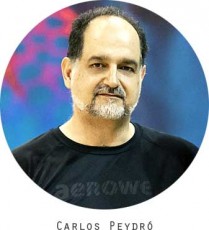
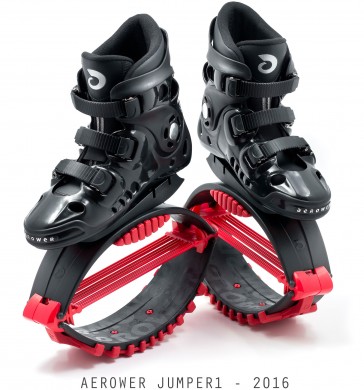
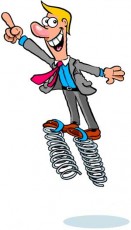
Our ancestors must not have always given up something, as fun as jumping, solely because of growing up. Sure not! Branches, wooden planks, rope bridges, hay bales, swings, the modern static bed or the simple act of riding for pleasure, have been used for the fun that occurs when we feel those moments of weightlessness. However, achieving this effect in a portable and practical way implies a more modern technology.
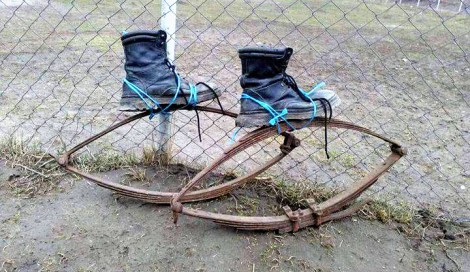
To be precise and not to get lost among a multitude of inventions to jump, we can limit it to the geometry we know of the current jumpers; That shape that has been proven to be the best system for rebound exercise in a simple, stable and safe way. I refer to the spring system consisting of two arches joined at their ends with one or more elatic bands between them.

With these characteristics, we can already assume that it is not necessary to go back many centuries. But if man was able to create the Antiticera artifact 22 centuries ago, who says there haven't been several inventors of jumpers we don't know? The activity of jumping is too much fun not to have tried on many occasions with better or worse results.
Inspired by the desire to know the history of this product and, seeing the amount of falsehoods that the propaganda of some companies have extended, makes me embark on the task of finding out everything I can about who was really the first to devise the first modern jumpers.
I have to admit that, before investigating the topic, I also participated in the diffusion of that generalized hoax that Kangoo Jumps invented this product. Now I wish I could atone for my sin with this post.
In my personal deal of many years with Denis Naville, founder of Kangoo Jumps and my partner in the company,(5) I realized quite soon that, really, he was not an engineer or a complete inventor, although he contributed some ideas. Denis was an economist and entrepreneur who knew how to take advantage of some opportunities and coincidences of life to achieve the first commercial success of a brand of jumpers.
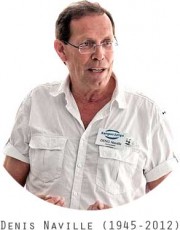
Bearing in mind that all the technical and creative development, since I started working in the company, was carried out in Spain by me and that the KJs are manufactured in Taiwan, it cannot be said that the "Swiss engineering" slogan we presumed and KJ continues doing it now..
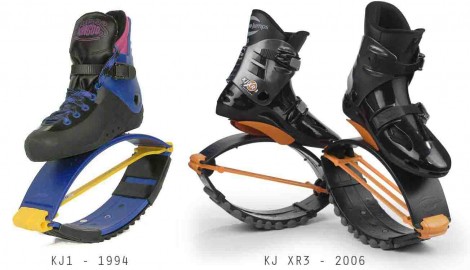
But the jumpers existed before. In my first approach to the history of the jumpers, I hoped to grant the title of inventor of the jumpers to Gregory Lekhtman, a Canadian of Russian origin and creator of the Exerlopers brand .
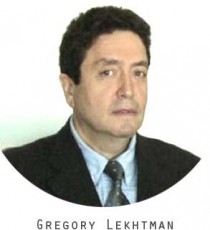
And I have been very tempted to do so because it appears in public documents of KJ and patent records indicate that he applied for the patent for this bounce system in 1990. He has invented and patented numerous products related to medicine and fitness(6). Although he was not really the first to patent a system like the one at hand, he was the first to market the jumpers,(7) in any case we have to recognize his merit.

Shortly before G. Lekhtman, there is quite a lot of documentation on the internet that grants the authority in the invention of this product to a more prolific Japanese inventor, Yoshiro Nakamatsu better known in his country by Dr. NakaMats.(8)



D. Naville already met the product and signed a distribution agreement for Europe in 1993. However, the chance made him meet the Taiwanese manufacturers of the Exerlopers and the PyongPyong at a fair in Munich, Germany. The succession of exact events is not very clear since there are ethical issues in between,(13) but what is clear is that Denis began marketing a Kangoo Jumps model, the KJ-1, exactly the same as the Exerlopers and both They are exactly the same as the PyonPyon:
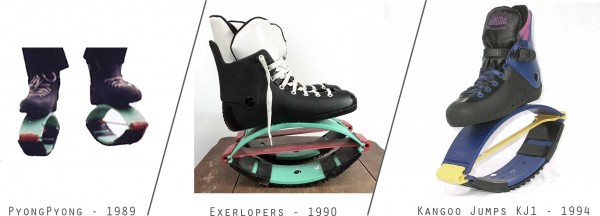
Denis saw that if he wanted to legally market the product he had to make some changes and that led him to ask for help from a French industrial design studio that used to work for the Salomon brand. He also developed his own patent in 1994 which was granted in 1996(14) and whose only innovation was the incorporation of some anti-collapse rubbers that he named as "Turbos" (15)
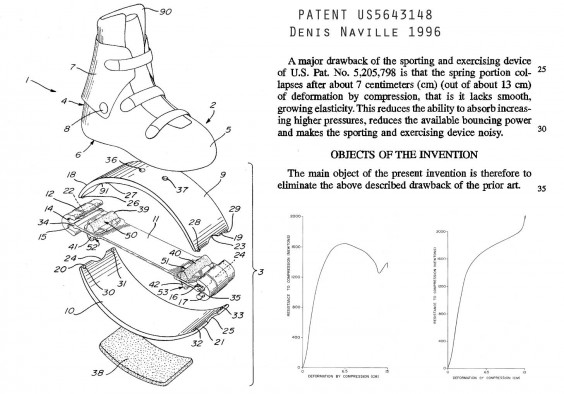
Gregory and Denis had a conflict for infringing, the latter, Gregory's previous patent but the innovation of the turbos was enough for the authorities to decide that he could keep it. Really what Kangoo Jumps patented were the turbos, not the jumpers. However, this mechanism was introduced before, in the Gregory patent of 1985, only what its anti-collapse function did not claim but was only as a structural piece.
I remember that I once asked Denis about Y. Nakamatsu's and he told me that he was an opportunist who patents the objects he has seen and believes interesting, in this case being an Exerlopers. The truth is that, observing their patents, they do not usually go into many details and less in ornamental aspects, but in this patent, their drawings coincide with the shape of the soles of their PyongPyong, the Exerlopers and the KJ1:
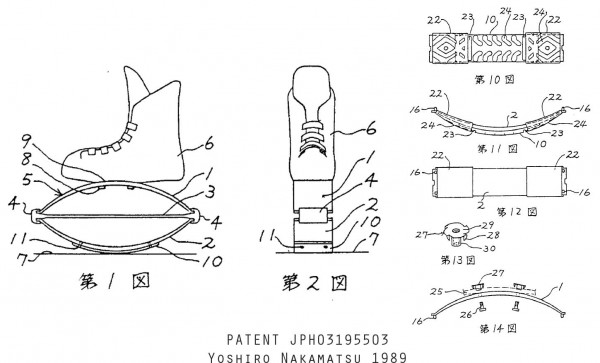
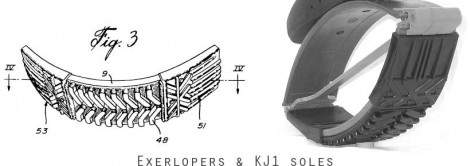
That is obviously not a coincidence, nor is it a coincidence that the factory that produces the three brands (and other own brands) is the same Taiwanese factory.
Personally, I think that Y. Nakamatsu has a bit of "patent troll"(16) but is not as aggressive as others (if he has not prosecuted Exerlopers and KJ) because his patents do not usually solve the most basic aspects and they are not usually technically and commercially viable if you don't add a lot of development. However he has others, as in this case, which is quite complete. So I am going to grant Y. Nakamatsu the merit of being the inventor of modern jumpers, who use synthetic polymers instead of metals, because the invention totally fits their profile, both in personality and in studies and trajectory, ah!, and his patent was earlier. I do not think that hundreds of magazine articles, internet and a movie(17) are wrong.
Currently Aerower is the only one of the aforementioned brands that has a jumpers patent in force due to the innovations it has developed. Aerower also has registered the designs of its main components(18) :


Investigating the patents I have been able to find the oldest reference of what we can consider jumpers according to the specifications that I mentioned above and dates from 1914 in France, It is described as a "sport or acrobatics device that adapts to a shoe and that it serves to increase the speed of the race or the amplitude of the jumps ". The patent is quite broad and includes alternative forms and mechanisms(20) .

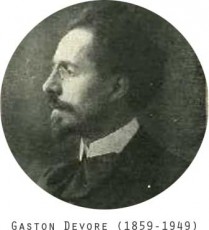
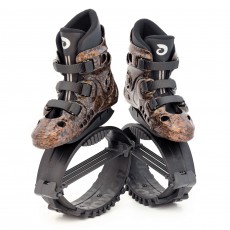
References:
(2) We will consider the originals as the first ones with a form reasonably similar to the current ones.
(3) https://jumpingsolutions.com/2018/09/12/which-rebound-boots-are-best/
(4) https://www.linkedin.com/in/carlospeydro/ and you can see also who was the "inventor" in KJ: in this design patent
(5) The Spanish company Rebound Zone SL established in La Nucia, Alicante(view) was and continues to be the real Head Office of the Kangoo Jumps brand and where employees work. The Switzerland RDM SA company is only a fiscal address without facilities in Sion, Switzerland.(view)
(7) https://www.youtube.com/watch?v=A6aks8xObHo
(8) https://en.wikipedia.org/wiki/Yoshiro_Nakamatsu
(9) https://www.smithsonianmag.com/science-nature/dr-nakamats-the-man-with-3300-patents-to-his-name-134571403
(10) https://aerower.com/D/Patente_Nakamatsu_1989.pdf
(11) https://aerower.com/D/Patente_Lekhtman_1985.pdf
(12) https://aerower.com/D/Patente_Lekhtman_1990.pdf
(13) I have great respect for Denis, he was a friend and almost like a father to me, but I am trying to be as objective as possible and unfortunately we cannot ask him his version of the history because he died in 2012 and I did not asked him when when he was alive because I didn't know what I know today. Real events and motivations can only be assumed after the views of those who are still alive and deduced using logic.
(14) https://aerower.com/D/Patente_Naville_1996.pdf
(15) The behavior of the arcs when they flex in each jump causes the elastic bands that unite them to stretch, but when the shape of the arches is already almost horizontal, the bands cease to give strength and produce an effect of "collapse" by reducing the resistance of the rebound system instead of increasing it. KJ turbos as well as Aerower's ACS (Anti-Collapse Safeguard) system are the only ones that compensate for that undesirable effect.(view)
(16) https://es.wikipedia.org/wiki/Trol_de_patentes
(17) https://www.imdb.com/title/tt1708535/
(18) https://aerower.com/D/Patente_Aerower_2015.pdf , https://aerower.com/D/EM700000003001999_0001.pdf , https://aerower.com/D/EM700000003001999_0002.pdf , https://aerower.com/D/EM700000003001999_0003.pdf y https://aerower.com/D/EM700000003001999_0004.pdf
(19) https://www.youtube.com/watch?v=rEfG0ruR4dM
(20) https://aerower.com/D/Patente_Devore_1914.pdf
(21) https://data.bnf.fr/13199333/gaston_devore/

